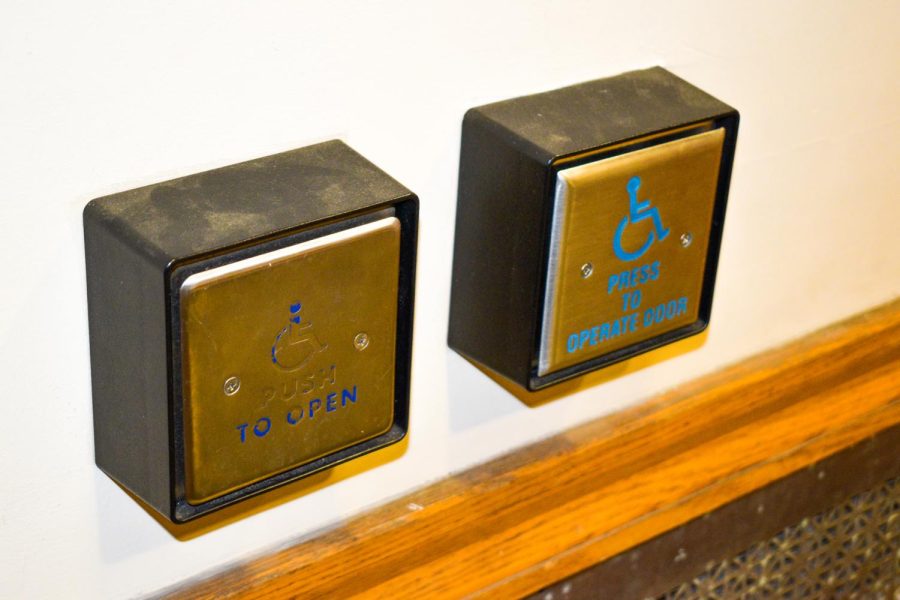Last semester, WGS 350 Intersectional Feminist Activisms brought to light accessibility concerns with its report on campus barriers to students with disabilities. Despite the increased awareness of this issue, little change has been manifested, including continually malfunctioning handicap door buttons and a lack of ramp access to buildings.
Dexter Kennedy ‘26, who uses a wheelchair, has struggled with getting into Farinon Student Center because of nonfunctional door buttons. Farinon has two doors to enter, meaning it requires four buttons.
“Not all of them together have worked since day one,” Kennedy said. “There has always been at least one broken button.”
Kennedy was not born disabled. For most of his life, he was able-bodied. It was only after graduating high school that Kennedy suffered a spinal cord injury that left him paralyzed. To move, he requires the use of a wheelchair.
Since coming to Lafayette, Kennedy has been impacted by the purportedly inaccessible features. He alleged that the college has been slow to respond to his needs. Because of those obstacles, Kennedy’s first year has been marked by challenges.
“It’s difficult to go through all of that and then face 20 different hurdles in the day here,” Kennedy said.
Kennedy, who lives in South Hall, could not get into the dorm by himself until March because of a lack of handicap buttons.
“They had the ramp but the door buttons weren’t installed. So they needed to install them, which took a long time,” Kennedy said. “[But] South had two doors to resection. And so they installed the buttons for the first outside doors, but then the second doors were still there so I couldn’t get in.”
Kennedy’s experiences served as the inspiration for last semester’s WGS 350 report. According to Meredith Forman ‘24, a student in the class, Kennedy came into class and talked to them about his experiences.
“It was really eye-opening,” Forman said. “The number of obstacles that exist that are really easy fixes that the college has money for and are just not being fixed.”
The report was well received, but the administration has yet to make some of the changes necessary to account make the campus more accessible. Forman mentioned that a major purpose of the report was to increase awareness about the issues people with disabilities face on campus.
“I definitely think awareness was increased, which is a really big part of student-led activism in general,” Forman said. “The more awareness and information that you can spread … the more change is going to happen, or at least the initiation of change.”
President Nicole Hurd said that she has been talking with students who have mobility access issues and is aware of the concerns about the push buttons.
“This is something near and dear to my heart, in terms of making sure that everybody at Lafayette can have a full experience. We’re not there yet. But we’re on that journey to make it happen,” Hurd said.
With the new campus master plan, Michael Chovanes, Associate Director of Facilities Operations, hopes to address these accessibility issues.
“The campus master planning effort is taking accessibility into account in a serious way,” Chovanes wrote in an email. “In the meantime, Facilities Operations is making the campus more accessible.”
Professor Dana Cuomo, the professor of WGS 350, mentioned that while accessibility is a part of the college’s master plan, that change is needed now.
“I know that accessibility is part of the master planning process. But master plans take a long time to execute,” Cuomo said. “I think there are certainly questions about things that can’t wait for the master plan to be finalized and to be executed.”
Forman echoed these sentiments, mentioning that these changes apply to more than just Kennedy.
“You break your foot, you’re in a boot or you’re on crutches, you can’t get places easily, you can’t get places at all. So I think a lot of students don’t realize the accessibility issues unless they were directly affected,” Forman said.
Kennedy emphasized that many of the changes are small and would not take very long to complete. He mentioned that the question of accessibility at Lafayette is less an issue of means and more an issue of will.
“If you just take a look around campus, you can actually see so many things that could very easily be made accessible,” Kennedy said, pointing to Kirby House. “There’s like two steps to get in. Do a small ramp. Do a very small ramp.”




































































































